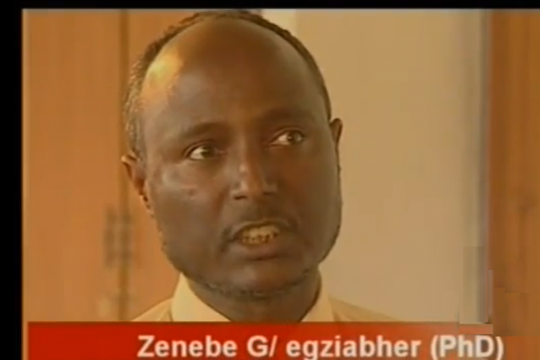Ethiopia is becoming the emerging power hub in East Africa in hope of meeting its growing energy requirements and exporting its surplus to the region. Currently the country is using only about 3% of the total power capacity. This documentary reviews the status of the two major hydropower dam construction activities taking place in the country: the Grand Renaissance Dam on the Blue Nile and the Gibe III on the Omo River. Senior Research Fellow of EEPFE, Dr. Zenebe Gebreegziabher, was among the interviewed in this program which was aired several times on the national TV in Ethiopia.
‘Energy is an important input in production and there is a close link between energy consumption and economic growth,’ said Dr. Zenebe, ‘the causality, however, is a debated issue: does energy cause growth or is it growth that leads to energy consumption? This is a country specific issue.In the context of Ethiopia evidence suggests that energy causes economic growth. Therefore, enhancing (ensuring) uninterrupted energy supply is important for sustaining the fast economic growth in Ethiopia.’
Ethiopia has power generating capacity amounting to over 60,000MW: 45,000 MW of hydropower, 10,000 MW wind energy, and 5,000MW geothermal energy. But the current generation is only 2000 MW. One of the objectives of the power sector is to make Ethiopia a green renewable energy hub for the East Africa region. The biggest dam construction in the country is the Grand Renaissance Dam which has a 6000 MW generating capacity followed by Gibe III which has 1870 MW generating capacity. Ethiopia has already started exporting 35 MW of electricityto Djibouti at a cost of 1.5 million dollars per month.
‘Currently Ethiopia is earning about 20-30 million USD from export of electricity to Djibouti.’ said Dr. Zenebe. ‘This will be next to coffee which is the most important foreign currency source in Ethiopia until recently. Ethiopia has more comparative advantage in exporting power because hydropower is the cheapest energy source. Countries that are importing this electricity source will be replacing power sources such as fossil fuel allowing them to concentrate these resources in areas where they see a better comparative advantage.’
By integrating this with electricity power, East African countries will reduce their energy costs.‘Energy costs are important components of production cost, energy production by itself requires energy, exporting a cheaper or lower cost source of power (electricity) to neighboring countries means that it will lower the production cost for products of these countries.’ added Dr. Zenebe. ‘This regional integration is also important because it will enhance secured and sustained power supply. Surpluses will be transmitted to places with power deficit. This in turn will also secure peace and stability regionally.’
External link for the complete documentary program on The Emerging Power Hub
